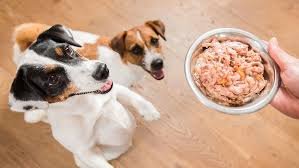In the vast sea of dog food options available in America, finding the perfect meal for your furry friend can feel like navigating a labyrinth.
With so many brands, ingredients, and dietary trends, it’s easy to get overwhelmed.
However, fret not, because in this guide, we’ll navigate through the essentials of choosing the right dog food to ensure your pooch’s health and happiness.

Understanding Your Dog’s Nutritional Needs :
Before delving into the world of dog food options, it’s crucial to understand your canine companion’s nutritional requirements.
Dogs, like humans, need a balanced diet to thrive.
This includes proteins, carbohydrates, fats, vitamins, and minerals.
Each nutrient plays a vital role in maintaining your dog’s overall health, from their coat to their immune system.
Deciphering Dog Food Labels :
Navigating the labels on dog food packages can be confusing. Phrases like “natural,” “grain-free,” or “organic” can sway your decision, but it’s essential to read beyond the marketing jargon.
Look for specific ingredients listed, ensuring that the primary protein source is named (like chicken or beef) rather than vague terms like “meat by-products.”
Types of Dog Food :
- Dry Dog Food :
Also known as kibble, dry dog food is a popular choice for its convenience and affordability.
It typically has a longer shelf life and can help maintain dental health by reducing tartar buildup. - Canned Dog Food :
Canned dog food offers higher moisture content, making it an excellent option for dogs who struggle with hydration.
It’s also more palatable for picky eaters and can be a suitable choice for dogs with dental issues.
Raw and Homemade Dog Food :Some pet owners opt for raw or homemade diets, believing it to be more natural and nutritious.
However, it’s essential to consult with a veterinarian or canine nutritionist to ensure the diet meets your dog’s nutritional needs.

Considerations for Special Dietary Needs :
Just like humans, dogs may have specific dietary requirements or restrictions.
Whether your dog has food allergies, sensitivities, or medical conditions like diabetes or kidney disease, there are specialized diets available to address these needs.
Consulting with your veterinarian is crucial in determining the right food for your pup’s unique situation.
The Importance of Quality Ingredients :
When selecting dog food, prioritize quality ingredients over flashy packaging or trendy marketing.
Opt for products with real meat as the primary ingredient, avoiding fillers, artificial preservatives, and additives.
Remember, investing in high-quality food now can lead to long-term savings on veterinary bills down the road.
Conclusion:
Choosing the right dog food is a crucial aspect of responsible pet ownership.
By understanding your dog’s nutritional needs, deciphering food labels, and considering special dietary requirements, you can ensure that your pooch stays healthy and happy for years to come.

FAQs:
1. What should I look for when reading dog food labels?
When reading dog food labels, look for named protein sources (like chicken or beef) as the primary ingredient, avoid artificial preservatives and additives, and ensure the food meets your dog’s specific dietary needs.
2. Is grain-free dog food healthier for my pet?
While some dogs may benefit from a grain-free diet, it’s not necessarily healthier for all pets.
Consult with your veterinarian to determine if a grain-free diet is suitable for your dog’s individual needs.
3. How can I tell if my dog has food allergies?
Common signs of food allergies in dogs include itching, skin irritation, gastrointestinal upset, and chronic ear infections.
If you suspect your dog has food allergies, consult with your veterinarian for proper diagnosis and treatment.
4. Can I switch my dog’s food abruptly, or should I transition gradually?
To avoid digestive upset, it’s best to transition your dog’s food gradually over the course of 7-10 days.
Start by mixing a small amount of the new food with their current food, gradually increasing the proportion of the new food each day.
5. Are raw or homemade diets safe for dogs?
Raw or homemade diets can be safe for dogs if properly balanced and formulated to meet their nutritional needs.
However, it’s crucial to consult with a veterinarian or canine nutritionist to ensure the diet is appropriate for your dog’s age, size, and health status.
